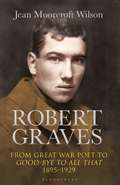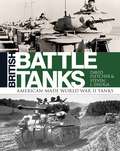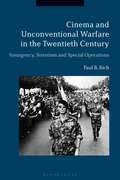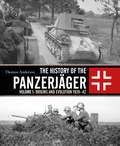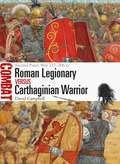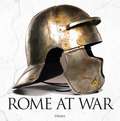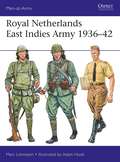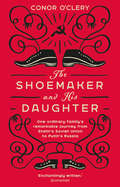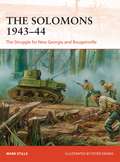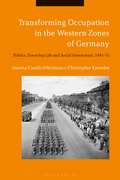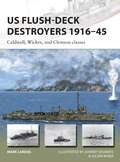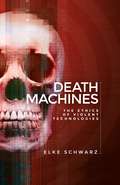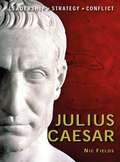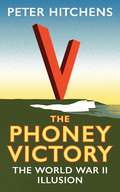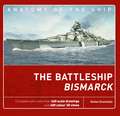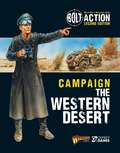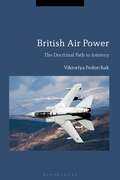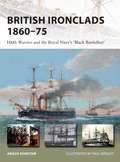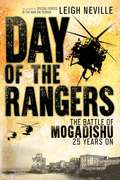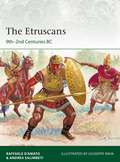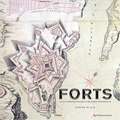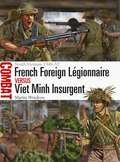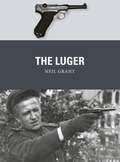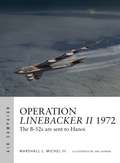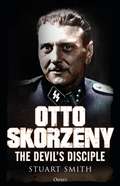- Table View
- List View
Robert Graves: From Great War Poet to Good-bye to All That (1895-1929)
by Jean Moorcroft WilsonThe writer and poet Robert Graves suppressed virtually all of the poems he had published during and just after the First World War. Until his son, William Graves, reprinted almost all the Poems About War in 1988, Graves's status as a 'war poet' seems to have depended mainly on his prose memoir (and bestseller), Good-bye to All That. None of the previous biographies written on Graves, however excellent, attempt to deal with this paradox in any depth. Robert Graves the war poet and the suppressed poems themselves have been largely neglected – until now. Jean Moorcroft Wilson, celebrated biographer of poets Siegfried Sassoon, Isaac Rosenberg and Edward Thomas, relates Graves's fascinating life during this period, his experiences in the war, his being left for dead at the Battle of the Somme, his leap from a third-storey window after his lover Laura Riding's even more dramatic jump from the fourth storey, his move to Spain and his final 'goodbye' to 'all that'. In this deeply-researched new book, containing startling material never before brought to light, Dr Moorcroft Wilson traces not only Graves's compelling life, but also the development of his poetry during the First World War, his thinking about the conflict and his shifting attitude towards it. Robert Graves: From Great War Poet to Good-bye to All That casts new light on the life, prose and poetry of Graves, without which the story of Great War poetry is incomplete.
British Battle Tanks: American-made World War II Tanks
by David Fletcher Steven J. ZalogaThe idea of British soldiers using American tanks was not viewed with a great deal of enthusiasm by the British Army. They perceived American tanks as being crudely made, mechanically unsophisticated and impossible to fight in. However, once British crews got used to them and learned to cope with some of their difficulties, such as limited fuel capacity and unfamiliar fighting techniques, they started to see them in a far more positive light, in particular their innate reliability and simplicity of maintenance. This book, the last in a three-part series on British Battle Tanks by armour expert David Fletcher, concentrates on World War II and studies American tanks in British service, some of which were modified in ways peculiar to the British. It shows how the number of these tanks increased to the point that they virtually dominated, as well describing some types, such as the T14 and M26 Pershing, which were supplied but never used in British service.
Cinema and Unconventional Warfare in the Twentieth Century: Insurgency, Terrorism and Special Operations
by Paul B. RichCinematic representations of unconventional warfare have received sporadic attention to date. However, this pattern has now begun to change with the rise of insurgency and counter-insurgency in Iraq and Afghanistan, and the growing importance of jihadist terrorism in the wake of 9/11. This ground-breaking study provides a much-needed examination of global unconventional warfare in 20th-century filmmaking, with case studies from the United States, Britain, Ireland, France, Italy and Israel. Paul B. Rich examines Hollywood's treatment of counter-terrorism and counter-insurgency in the United States; British post-colonial insurgencies in Malaya and Kenya and British special operations in the Second World War; the Irish conflict before and during the Troubles; French filmmaking and the reluctance to deal with the bitter war in Algeria in the 1950s; Italian neorealism and its impact on films dealing with urban insurgency by Roberto Rossellini, Nanni Loy and Gillo Pontecorvo, and Israel and the upsurge of Palestinian terrorism. Whilst only a small number of films on these conflicts have been able to rise above stereotyping insurgents and terrorists - in some cases due to a pattern of screen orientalism - Cinema and Unconventional Warfare in the Twentieth Century stresses the positive political gains to be derived from humanizing terrorists and terrorists movements, especially in the context of modern jihadist terrorism. This is essential reading for academics, postgraduates and advanced undergraduates interested in 20th-century military history, politics and international relations, and film studies.
The History of the Panzerjäger: Volume 1: Origins and Evolution 1939–42
by Thomas AndersonThe German Panzerjäger, or Panzerjägertruppe, was one of the most innovative fighting arms of World War II and its story has never properly been told. Many books have focused on an element of the story – the Hetzer, Jagdpanzer, Jagdpanther – but this is the first time that the whole story of the development and organization of Nazi Germany's anti-tank force will have been covered, from its earliest origins in World War I, through its development in the interwar period, and its baptism of fire in the early days of World War II. This is the first of two volumes that will trace the story through the glory years of Blitzkrieg and the improvements that were made when Soviet tanks were first encountered, leading to new weapons, tactics and organization. It is packed with previously unpublished wartime photographs, combat reports, and detailed charts and statistics to give an unparalleled account of this unique arm of the Wehrmacht.
Roman Legionary vs Carthaginian Warrior: Second Punic War 217–206 BC (Combat)
by Adam Hook David CampbellThe peace that followed the First Punic War was shallow and fractious, with the resumption of hostilities in 218 BC sparked by Carthaginian expansion in Iberia seeing Rome suffer some of the worst defeats in her entire history. The Carthaginian army was a composite affair primarily made up of a number of levies from Africa and around the Mediterranean augmented by mercenaries and allies, and these troops crushed the Roman heavy infantry maniples in a series of battles across Southern Europe. Improvements made to their military, however, would see Roman revenge visited on Hannibal in full measure by Scipio, who would beat him at his own game and bring Roman legions to the gates of Carthage itself. In this study, the epic battles at Lake Trasimene (217 BC), Cannae (216 BC), and Ilipa (206 BC) are explored in detail, supported by carefully chosen illustrations and specially commissioned full-colour artwork and mapping.
Rome at War
by Bloomsbury PublishingThe Roman Empire was the greatest the world has ever seen, and its legendary military might was the foundation of this success.This compact volume tells the fascinating story of the major conflicts that shaped the empire, from Julius Caesar's bloody Gallic Wars and the Civil War against Pompey that left the victorious Caesar Dictator of Rome, through the wars of expansion to its decline and fragmentation. Beautiful full colour artwork of the soldiers and battles bring the Roman world to life, along with images and colour maps.
Royal Netherlands East Indies Army 1936–42 (Men-at-Arms)
by Adam Hook Marc LohnsteinUntil 1945, Indonesia was a Dutch colony known as the Netherlands East Indies. In 1930, the area had over 60 million inhabitants and was a major exporter to Japan, providing some 13 per cent of its oil needs – second only after the United States. Following Germany's occupation of the Netherlands in May 1940, Japan decided to expand its influence in the Netherlands East Indies.Defending the colony was the Royal Netherlands East Indies Army (KNIL). This force, designed primarily for colonial policing, underwent a series of cutbacks in the interwar years before adopting a modernisation programme in 1936, which focused on building up a strike air force, introducing tanks and increasing the firepower of the infantry and artillery.Fully illustrated with period photographs and full-colour artwork, this book examines the dress, insignia, equipment, organization and combat performance of the Royal Netherlands East Indies Army as it faced the all-conquering Japanese forces in World War II.
The Shoemaker and his Daughter
by Conor O'Clery'An arresting and evocative story.' Keggie Carew, author of Dadland'Welcomed by everyone who cares about good writing and human stories.' Richard Lloyd Parry, author of Ghosts of the Tsunami'A tour de force ... O'Clery is a gifted writer.' Luke Harding, bestselling author of CollusionThe Soviet Union, 1962. Shoemaker Stanislav Suvorov is imprisoned for five years. His crime? Selling his car for a profit, contravening the Kremlin’s strict laws of speculation. Laws which, thirty years later, his daughter Zhanna helps to unravel. In the new Russia, yesterday’s crime is today’s opportunity.On his release from prison, social shame drives Stanislav to voluntary exile in Siberia, moving his family from a relatively comfortable, continental life in Grozny, the capital of Chechnya, to frigid, farthest-flung Krasnoyarsk. For some, it is the capital of the gulag. For others, it is the chance to start over again. These are the last days of a Soviet Union in which the Communist Party and KGB desperately cling to power, in which foreigners are unwelcome and travel abroad is restricted, where the queues for bread are daily and debilitating and where expressing views in favour of democracy and human rights can get you imprisoned or sent into exile. The Shoemaker and His Daughter takes in more than eighty years of Soviet and Russian history through the prism of one family – a family author Conor O’Clery knows well: he is married to Zhanna. It paints a vivid picture of a complex part of the world at a seismic moment in its history: of erratic war and uneasy peace; of blind power and its frequent abuse; of misguided ideologies and stifling bureaucracy; of the slow demise of Communism and the chaotic embrace of capitalism. The Suvorovs witness it all. Both intimate and sweeping in scale, this is a story of ordinary lives battered and shaped by extraordinary times.
The Solomons 1943–44: The Struggle for New Georgia and Bougainville (Campaign)
by Peter Dennis Mark Stille Bounford.com Bounford.com Paul KimeVictory at Guadalcanal for the Allies in February 1943 left them a vital foothold in the Solomon Islands chain, and was the first step in an attempt to isolate and capture the key Japanese base of Rabaul on New Britain. In order to do this they had to advance up the island chain in a combined air, naval, and ground campaign. On the other hand, the Japanese were determined to shore up their defences on the Solomons, which was a vital part of their southern front, and would bitterly contest every inch of the Allied advance. The scene was set for one of the bloodiest campaigns of the Pacific War. Fully illustrated with specially commissioned maps and artwork, this is the compelling story of the struggle for the Solomons, a key part of the Allied advance towards Japan which saw tens of thousands of casualties and so many ships lost that part of the ocean became known as 'Ironbottom Sound'.
Transforming Occupation in the Western Zones of Germany: Politics, Everyday Life and Social Interactions, 1945-55
by Camilo Erlichman Christopher KnowlesTransforming Occupation in the Western Zones of Germany provides an in-depth transnational study of power politics, daily life, and social interactions in the Western Zones of occupied Germany during the aftermath of the Second World War. Combining a history from below with a top-down perspective, the volume explores the origins, impacts, and legacies of the occupations of the western zones of Germany by the United States, Britain and France, examining complex yet topical issues that often arise as a consequence of war including regime change, transitional justice, everyday life under occupation, the role of intermediaries, and the multifaceted relationship between occupiers and occupied. Adopting a novel set of approaches that puts questions of power, social relations, gender, race, and the environment centre stage, it moves beyond existing narratives to place the occupation within a broader framework of continuity and change in post-war western Europe. Incorporating essays from 16 international scholars, this volume provides a substantial contribution to the emerging fields of occupation studies and the comparative history of post-war Europe.
US Flush-Deck Destroyers 1916–45: Caldwell, Wickes, and Clemson classes (New Vanguard #259)
by Johnny Shumate Mark Lardas Julian BakerFour pipes and flush decks – these ships were a distinctively American destroyer design. Devised immediately prior to and during the United States' involvement in World War I they dominated the US Navy's destroyer forces all the way through to World War II. They were deployed on North Atlantic and Norwegian Sea convoys, and virtually everywhere in the Pacific, from Alaska to Australia. Fifty were given to Great Britain in its hour of need in 1940, and many would serve in other navies, fighting under the Soviet, Canadian, Norwegian, and even the Imperial Japanese flags. They also served in a variety of roles becoming seaplane tenders, high-speed transports, minesweepers and minelayers. One was even used as a self-propelled mine during Operation Chariot, destroying the dry dock at St. Nazaire.Fully illustrated throughout with commissioned artwork and contemporary photographs, this volume reveals the operational history of these US Navy ships that fought with distinction in both World Wars.
Death machines: The ethics of violent technologies
by Elke SchwarzDeath Machines offers a critical reconsideration of ethical theories and political justifications for technologised practices of violence in contemporary conflicts.
Julius Caesar (Command)
by Peter Dennis Nic FieldsOne of the greatest military commanders in history, Julius Caesar's most famous victory – the conquest of Gaul – was to him little more than a stepping stone to power. An audacious and decisive general, his victories over the Gauls allowed him to challenge for the political leadership of Rome. Leading a single legion across the Rubicon in 49 BC, Caesar launched a civil war which would end the Roman Republic and usher in the Roman Empire, with Caesar at its helm. This examination of the great general's life covers his great victories and few defeats, looking at the factors which lay behind his military genius.
The Phoney Victory: The World War II Illusion
by Peter HitchensWas World War II really the `Good War'? In the years since the declaration of peace in 1945 many myths have sprung up around the conflict in the victorious nations. In this book, Peter Hitchens deconstructs the many fables which have become associated with the narrative of the `Good War'. Whilst not criticising or doubting the need for war against Nazi Germany at some stage, Hitchens does query whether September 1939 was the right moment, or the independence of Poland the right issue. He points out that in the summer of 1939 Britain and France were wholly unprepared for a major European war and that this quickly became apparent in the conflict that ensued. He also rejects the retroactive claim that Britain went to war in 1939 to save the Jewish population of Europe. On the contrary, the beginning and intensification of war made it easier for Germany to begin the policy of mass murder in secret as well as closing most escape routes. In a provocative, but deeply-researched book, Hitchens questions the most common assumptions surrounding World War II, turning on its head the myth of Britain's role in a `Good War'.
The Battleship Bismarck (Anatomy of The Ship #1)
by Stefan DraminskiThe Bismarck is perhaps the most famous – and notorious - warship ever built. Completed in 1941, the 45,000-ton German battleship sunk HMS Hood, the pride of the British Navy, during one of the most sensational encounters in naval history. Following the sinking, Bismarck was chased around the North Atlantic by many units of the Royal Navy. She was finally dispatched with gunfire and torpedoes on 27 May, less than five months after her completion. Her wreck still lies where she sank, 4,800m down and 960km off the west coast of France. Drawing on new research and technology, this edition is the most comprehensive examination of Bismarck ever published. It includes a complete set of detailed line drawings with fully descriptive keys and full-colour 3D artwork, supported by technical details, photographs and text on the building of the ship and a record of the ship's service history.
Bolt Action: The Western Desert (Bolt Action)
by Warlord Games Peter DennisOne of the most popular and enduring campaigns of World War II is that of the Western Desert, where Allied armies beat back the hard-pressed German and Italian forces under the gruelling African sun. Covering crucial operations such as Crusader, Lightfoot, and Supercharge, and the great battles of Tobruk, El Alamein, and Gazala, this book brings the unforgiving battlefields of North Africa to the tabletop. In-depth information on the forces involved, linked scenarios, and new Theatre Selectors make this an ideal resource for any Bolt Action player with an interest in the Desert War.
British Air Power: The Doctrinal Path to Jointery
by Viktoriya FedorchakBritish Air Power demonstrates how the Royal Air Force sought to adapt in regard to the roles it could play and the conflicts in which it could be used, as well as the evolution of air power doctrine at a time of rapid changes in national politics and in the international arena. The development of new concepts and theories, the evaluation of operational experience, the political environment and budgetary cuts, and the role of academics and personalities in development of doctrine are thus all explored to show changes in strategic thinking regarding air power.Fedorchak further examines the influence of jointery – the process of co-operation between the army, navy and air force – on thinking, conceptualising, teaching and using air power in recent operations in Afghanistan, Iraq, Libya and Syria. A contemporary complement to more historical studies, British Air Power provides a very detailed look at the development of air-land doctrine in the RAF since the turn of the century.
British Ironclads 1860–75: HMS Warrior and the Royal Navy's 'Black Battlefleet' (New Vanguard)
by Paul Wright Angus KonstamIn November 1859, the French warship La Gloire was launched. She was the world's first seagoing ironclad - a warship built from wood, but whose hull was clad in a protective layer of iron plate. Britain, not to be outdone, launched her own ironclad the following year - HMS Warrior - which, when she entered service, became the most powerful warship in the world. Just like the Dreadnought half a century later, this ship changed the nature of naval warfare forever, and sparked a frantic arms race. The elegant but powerful Warrior embodied the technological advances of the early Victorian era, and the spirit of this new age of steam, iron and firepower. Fully illustrated with detailed cutaway artwork, this book covers the British ironclad from its inception and emergence in 1860, to 1875, a watershed year, which saw the building of a new generation of recognisably modern turreted battleships.
Day of the Rangers: The Battle of Mogadishu 25 Years On
by Leigh NevilleOn October 3, 1993, Task Force Ranger was dispatched to seize two high-profile lieutenants of a Somali warlord. Special Forces troops were transported by ground vehicles and helicopters, and the mission was meant to be over within the hour. They quickly found themselves under heavy fire, and two Black Hawk helicopters were shot down. With a hastily organized relief column many hours away, the American troops faced a desperate battle for survival.Focusing on the stories of the soldiers on the ground, and in the air, Day of the Rangers reveals the experiences and recollections of the Special Forces units, including the Rangers, Delta operators and Nightstalker crews who fought in the battle of Mogadishu. Published to mark the battle's 25th anniversary and using recently declassified documents and new interviews with many of the participants, Day of the Rangers is a fascinating and revealing new history of a battle that would influence American Special Forces for decades to come.
The Etruscans: 9th–2nd Centuries BC (Elite)
by Giuseppe Rava Andrea Salimbeti Raffaele D’AmatoAncient Rome had deep roots in the 'Villanovan' culture that we call today the Etruscans. Their long-lived civilization can be traced to 900–750 BC in north-west Italy. They were a sea-faring people trading with and competing against Greek and Phoenician peoples, including the Carthaginians. They were also a great land-based power, especially in the 'Classical' period, where they expanded their power north into the Po Valley and south to Latium. In the 6th century BC an Etruscan dynasty ruled Rome, and their power extended southwards to the Amalfi coast. In 509 BC the Romans rose up to expel their kings, which began the long 'Etruscan twilight' when their power was squeezed by the Samnites and, most especially, the Romans. Drawing on archaeological evidence including warrior tombs, paintings, sculptures, and fully illustrated throughout, this study examines one of the early rivals to Ancient Rome.
Forts: An illustrated history of building for defence
by The National ArchivesEver since humans began to live together in settlements they have felt the need to organise some kind of defence against potentially hostile neighbours. Many of the earliest city states were built as walled towns, and during the medieval era, stone castles were built both as symbols of the defenders' strength and as protection against potential attack. The advent of cannon prompted fortifications to become lower, denser and more complex, and the forts of the eighteenth and nineteenth centuries could appear like snowflakes in their complexity and beautiful geometry. Without forts, the history of America could have taken a very different course, pirates could have sailed the seas unchecked, and Britain itself could have been successfully invaded. This book explains the history of human fortifications, and is beautifully illustrated using photographs, plans, drawings and maps to explain why they were built, their various functions and their immense historical legacy in laying the foundations of empire.
French Foreign Légionnaire vs Viet Minh Insurgent: North Vietnam 1948–52 (Combat)
by Martin Windrow Johnny ShumateThe French Indochina War (1946–54) was the largest of the first generation of post-World War II wars of decolonization as Vietminh insurgents sought to topple their French colonial masters. It was also unique in that the insurgency evolved from low-level guerrilla activity to mobile operations by a large conventional army which finally defeated a large European-led expeditionary force, supported by artillery, armour and airpower. The war's progress was almost entirely dictated by the extreme terrain, and by the Chinese support enjoyed by the Vietnamese insurgents. The actions explored in this study cover three contrasting phases of the war in Tonkin during 1948–52, setting both sides on the path that would lead to the conflict's climactic encounter at Dien Bien Phu in 1954.Featuring specially commissioned artwork and drawing upon a range of sources, this meticulously researched study casts new light on the troops who fought on both sides in this evolving and momentous conflict.
The Luger (Weapon)
by Johnny Shumate Neil Grant Alan GillilandPatented in 1898 and produced from 1900, Georg Luger's iconic semi-automatic pistol became synonymous with Germany's armed forces throughout both world wars. Initially chambered for the 7.65×21mm round, from 1902 the Luger was designed for DWM's 9×19mm round, which even today remains the most popular military handgun cartridge. It was adopted by the Imperial German Navy in 1904, followed by the German Army in 1908, receiving the name Pistole 08. Despite being supplanted by the Walther P38, the Luger remained in widespread service with all arms of Nazi Germany's armed forces throughout World War II, and even equipped East Germany's Volkpolizei in the years after 1945.Featuring full-colour artwork, expert analysis and archive and present-day photographs, this engaging study tells the story of the Luger, the distinctive and deadly semi-automatic pistol that has come to symbolize Germany's armed forces in the 20th century.
Operation Linebacker II 1972: The B-52s are sent to Hanoi (Air Campaign)
by Jim Laurier Adam Tooby Bounford.com Bounford.com Paul Kime Marshall Michel IIIAfter the failed April 1972 invasion of South Vietnam and the heavy US tactical bombing raids in the Hanoi area, the North Vietnamese agreed to return to the Paris peace talks, yet very quickly these negotiations stalled. In an attempt to end the war quickly and 'persuade' the North Vietnamese to return to the negotiating table, President Nixon ordered the Air Force to send the US' ultimate conventional weapon, the B-52 bomber, against their capital, Hanoi. Bristling with the latest Soviet air defence missiles, it was the most heavily defended target in Vietnam. Taking place in late December, this campaign was soon dubbed the 'Christmas Bombings'. Using specially commissioned artwork and maps, ex-USAF fighter colonel Marshall Michel describes Linebacker II, the climax of the air war over Vietnam, and history's only example of how America's best Cold War bombers performed against contemporary Soviet air defences.
Otto Skorzeny: The Devil’s Disciple
by Stuart SmithSS-Obersturmbannführer Otto Skorzeny became a legend in his own time. 'Hitler's favourite commando' acquired a reputation as a man of daring, renowned for his audacious 1943 mission to extricate Mussolini from a mountain-top prison. Skorzeny's influence on special operations doctrine was far-reaching and long-lasting – in 2011, when US Navy SEALs infiltrated Pakistan to eliminate Osama Bin Laden, the operational planning was influenced by Skorzeny's legacy. Yet he was also an egoist who stole other men's credit (including for the seminal rescue of Mussolini), brave and resourceful but also an unrepentant Nazi and a self-aggrandizing hogger of the limelight. Stuart Smith draws on years of in-depth research to uncover the truth about Skorzeny's career and complex personality. From his background as a student radical in Vienna, to his bloody service with the Waffen-SS on the Eastern Front, his surprise rebirth as a commando, and his intriguing post-war career and mysterious fortune, this book tells Otto Skorzeny's story in full – warts and all – for the first time.
